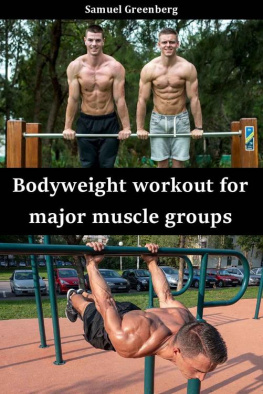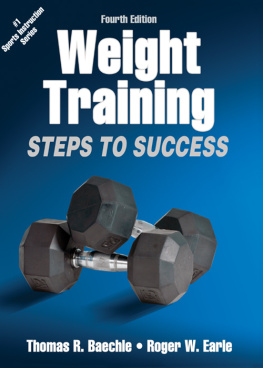
Jim Stoppanis Encyclopedia of Muscle & Strength
Second Edition
Jim Stoppani, PhD

Human Kinetics
[Library of Congress Info]
ISBN: 978-1-4504-5974-7 (print)
Copyright 2015, 2006 by Jim Stoppani
All rights reserved. Except for use in a review, the reproduction or utilization of this work in any form or by any electronic, mechanical, or other means, now known or hereafter invented, including xerography, photocopying, and recording, and in any information storage and retrieval system, is forbidden without the written permission of the publisher.
This publication is written and published to provide accurate and authoritative information relevant to the subject matter presented. It is published and sold with the understanding that the author and publisher are not engaged in rendering legal, medical, or other professional services by reason of their authorship or publication of this work. If medical or other expert assistance is required, the services of a competent professional person should be sought.
The web addresses cited in this text were current as of June 2014, unless otherwise noted.
Acquisitions Editor: Justin Klug
Senior Managing Editor: Amy Stahl
Associate Managing Editor: Anne Mrozek
Copyeditor: Jan Feeney
Indexer: Michael Ferreira
Permissions Manager: Martha Gullo
Graphic Designer: Nancy Rasmus
Graphic Artist: Francine Hamerski
Cover Designer: Keith Blomberg
Photograph (cover): Pavel Ythjall
Photographs (interior): Neil Bernstein, unless otherwise noted; figures 4.1, 4.7, 4.9, 4.14, 4.15, 4.32, and 4.37 courtesy of Jim Stoppani; courtesy of Robert Q. Riley Enterprises
Visual Production Assistant: Joyce Brumfield
Photo Production Manager: Jason Allen
Art Manager: Kelly Hendren
Associate Art Manager: Alan L. Wilborn
Illustrations: Human Kinetics, unless otherwise noted
Printer: Sheridan Books
We thank Metroflex Gym in Long Beach, California, for assistance in providing the location for the photo shoot for this book.
Human Kinetics books are available at special discounts for bulk purchase. Special editions or book excerpts can also be created to specification. For details, contact the Special Sales Manager at Human Kinetics.
Printed in the United States of America
10 9 8 7 6 5 4 3 2 1
The paper in this book is certified under a sustainable forestry program.
Human Kinetics
Website: www.HumanKinetics.com
United States: Human Kinetics
P.O. Box 5076
Champaign, IL 61825-5076
800-747-4457
e-mail: humank@hkusa.com
Canada: Human Kinetics
475 Devonshire Road Unit 100
Windsor, ON N8Y 2L5
800-465-7301 (in Canada only)
e-mail: info@hkcanada.com
Europe: Human Kinetics
107 Bradford Road
Stanningley
Leeds LS28 6AT, United Kingdom
+44 (0) 113 255 5665
e-mail: hk@hkeurope.com
Australia: Human Kinetics
57A Price Avenue
Lower Mitcham, South Australia 5062
08 8372 0999
e-mail: info@hkaustralia.com
New Zealand: Human Kinetics
P.O. Box 80
Torrens Park, South Australia 5062
0800 222 062
e-mail: info@hknewzealand.com
E6002
Contents
Part I
Training Essentials

Strength training can be traced back to the beginning of recorded time. As early as 2000 b.c.e., the ancient Egyptians lifted sacks of sand to strength-train for hunting and military duty. According to military records, the Chinese also used strength training for their military personnel as early as 700 b.c.e. But the historical association that most people are familiar with is the ancient Greeks. Many of the athletes who competed in the ancient Olympics lifted heavy stones to develop strength and boost their athletic performance. Besides those functional results, strength training provided the development of a muscular physique. This masculine physique was honored in classic Greek art and writing. In fact, it may be the ancient Greek cultures celebration of muscle that is responsible for spawning the modern sport of bodybuilding. Several famous athletes during that period, such as Milo and Heracles, often performed feats of strength and displayed their muscularity to spectators. In the 19th century, the appreciation by the masses for heavily muscled physiques made celebrities out of many performing strongmen of that time. The most famous was Eugen Sandow, who is considered the father of bodybuilding.
Despite the fact that humans have a longstanding fascination with strength and muscularity, the concept of strength training is one that few have familiarized themselves with. Even during the fitness boom of the 1970s in the United States, most Americans participated in some form of aerobic exercise but neglected the strength component of physical fitness. Over the years, with help from pioneers of strength training (such as Bob Hoffman, Joe Weider, and Charles Atlas) and through advances in research on the developing science of resistance training, strength became viewed as a necessary component of physical fitness and athletic performance. And participation in strength training grew faster than participation in any other physical activity.
As the popularity of strength training grew, so did awareness that this practice was a complicated science that participants must fully understand in order to reap the true benefits. That is why part I of this book is so important for anyone interested in strength training at any level. Unless you clearly understand the principles of strength training, you will never fully comprehend how to implement an effective strength training program.
So before you skip ahead to one of the strength training programs in parts II, III, and IV, be sure you have a decent grasp of the fundamentals presented in these first four chapters. Armed with this background, you will have a much fuller understanding of the exercises, techniques, and programs presented in the other chapters. You also will be more capable of individualizing these techniques to create specialized programs for yourself and for others.
Chapter 1
Core Concepts
Strength training is performed by a wide range of people for a variety of reasons. Most are interested in gaining muscle strength and muscle mass with a concomitant loss of body fat. In addition, many people expect these physical adaptations to carry over into improvements in performance of athletic endeavors and daily life activities. Strength training can provide these adaptations as long as you follow certain principles, which are discussed here to help you realize your strength training goals. These principles are integral to understanding how strength training works, how to individualize it to meet your needs and goals, and how to change it to continue making adaptations as you progress.
In addition to understanding the concepts of strength training, you must be familiar with the terminology that is often used in discussions of strength training. Having the ability to understand and use this lexicon will help you to learn the fundamentals of strength training and to communicate with others who participate in strength training. To familiarize yourself with this vocabulary, refer to the glossary at the end of this book.















